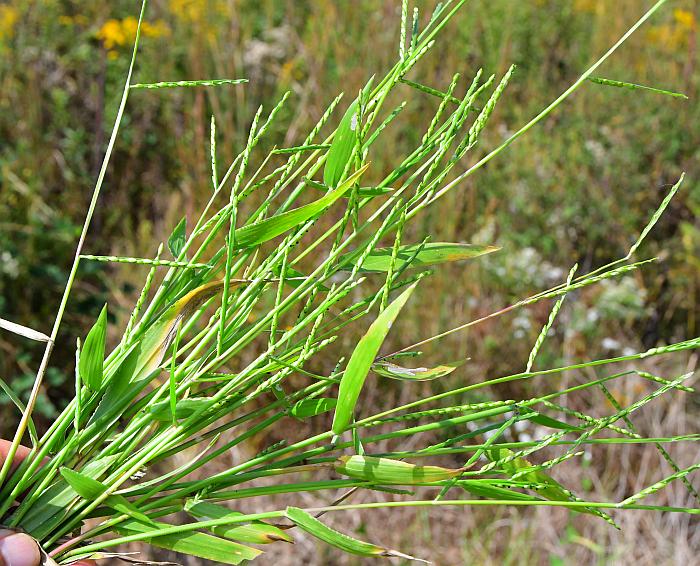Urochloa platyphylla (Munro ex C. Wright) R.D. Webster
Broadleaf Signalgrass

Introduced
CC = *
CW = 0
MOC = 11
© SRTurner
Urochloa platyphylla (Munro ex C. Wright) R.D. WebsterBroadleaf Signalgrass | |
 |
Introduced CC = * CW = 0 MOC = 11 |
© SRTurner |
|
Family - Poaceae/Paniceae Habit - Annual grass with C4 photosynthesis. Stems - Flowering stems to 70 cm long, often multiple from the base, erect or prostrate at the base and rooting at the lower nodes.
Leaves - Leaf sheaths hairy, the ligule a minute membrane 0.5-1.0 mm long with a fringe of hairs along the margin. Leaf blades flat, 3-15 cm long, 4-13 mm wide, glabrous except sometimes at the very base.
Inflorescences - Inflorescence panicles with simple primary branches, 5-20 cm long, with the 2-8 loosely spaced primary branches consisting of 1-sided spikelike racemes, these 2.5-7.5 cm long, ascending to spreading, with 10 to numerous spikelets, including a spikelet at the tip.
Spikelets - Spikelets 3.5-4.5 mm long, glabrous. Lower glume 1.2-1.8 mm long, ovate, rounded to bluntly pointed at the tip, 5-nerved. Upper glume 3.5-4.5 mm long, ovate, bluntly to sharply pointed at the tip, 7-nerved, with a fine network of cross-wrinkles or veins toward the tip between the nerves. Lowermost floret with the lemma 3.5-4.5 mm long, ovate, bluntly to sharply pointed at the tip, 7-nerved, with a fine network of cross-wrinkles or veins toward the tip between the nerves. Fertile floret with the lemma 2.5-3.4 mm long, elliptic-ovate, bluntly pointed, often with a small, sharp, hornlike point just behind the tip. Anthers 0.6-1.0 mm long.
Fruits - Caryopses 1.7-2.0 mm long, yellow. Flowering - August - November. Habitat - Crop fields, ditches, roadsides, railroads, sandy disturbed open areas. Origin - Native to the U.S., probably introduced in Missouri. Lookalikes - Species of Paspalum and Brachiaria. Other info. - In Missouri this grass is restricted mostly to the southeastern corner of the state. It is considered introduced, although the Missouri populations are contiguous with the native range, which extends southward as far as the Gulf Coast and from Texas to Florida. In appearance the plant resembles a Paspalum, with the inflorescence bearing several unbranched spikes (actually spikelike racemes). These are conspicuously one-sided, with a single row of spikelets lined up along a flat rachis which terminates in a spikelet. The spikelets are glabrous, and the leaves mostly so. Unlike species of Paspalum, U. platyphylla spikelets have two well-formed glumes. Photographs taken at Duck Creek Conservation Area, 10-5-2021 (SRTurner). |